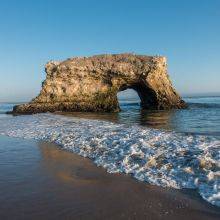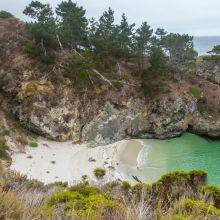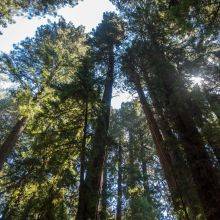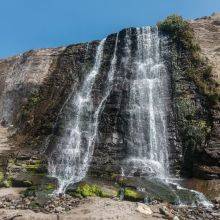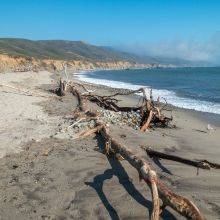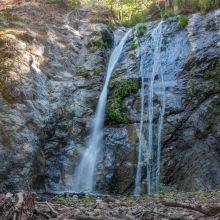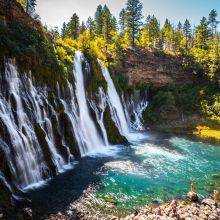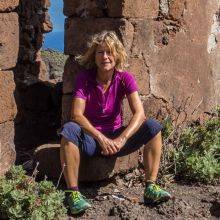When Is the Best Time
The CZU Lightning Complex Fire in August 2020 burned over 18,000 acres, or 97% of Big Basin State Park, to the ground. Nothing was left, including the well-developed headquarters, campgrounds, picnic areas, shops, outdoor theatre, and all infrastructure, from water to electricity and internet. The good news is that the old redwoods were more resilient than expected and had already started to regrow with fresh green needles at black branches and trunks.
Luckily, no one died—more than 1,000 people, including visitors, campers, and park staff, were evacuated in three hours because the fire rolled quickly into the park during the busiest season.
With the public's input, plans to reestablish this wonderful State Park are underway. A return to fully opening the park is prioritized. Some campgrounds will be relocated, a shuttle will be introduced, and trails will be newly developed. However, the park is already open for visitors, and several trails are accessible this year, 2024.
Big Basin Redwoods is a popular State Park close to San Francisco, and it will be again a fantastic place for camping under the astonishing trees. This article and pictures are dedicated to the oldest State Park in California, 65 miles south of San Francisco. My pictures were taken before the fire, but the biggest trees still exist.
Scientists believe nine out of ten majestic redwoods survived, but none of us will see this park in its glory again; it simply takes much longer than a lifetime. However, you can witness how resilient Mother Nature can be.
Is Big Basin Open?
YES, the park is open for day use. Plenty of short and half-day hikes are already accessible.
Hundreds of people are working here to develop new roads and trails and a memory of what happened for future generations. The difference after the devastating fire is profound, with blackened trunks everywhere. Some places are a lot thinner now. It is a big task to get the State Park fully reopened.
Do you wish to visit Big Basin during the weekend? Due to the limited number of parking spaces, it is on a first-come, first-served basis. Here is my tip on how to definitely get into the park, even at midday.
Take the bus of the Santa Cruz Metro, bus route 35 in spring and summer: no fee and no parking hassle. Bus schedule and more information
Weather in the Big Basin Area
The wet season starts in November and lasts until February, with most precipitation in January. It receives three times the rainfall of the Bay Area. This rain is much needed by the redwoods after the dry summer. The average night temp is around 41°F/5°C, and the day temp under 60°F/15°C.
Summer from June to September is primarily dry, with dense summer fog in the morning. The mist provides the trees with moisture. Nights temps are much cooler than in the Bay Area with around 49°F / 9°C and day temps about 74°F/23°C. In the hot summer months, temps frequently climb up to 86°F/30°C and more.
Decreasing Fog
Such devastating fires can occur in the summer through lightning, but the iconic fog where all vegetation and the thousands of of-year-old redwoods depend on is disappearing in the Bay Area. More than 30% fog reduction; the fog starts later, ends earlier, and also fewer hours of fog during the day. But the redwoods, lichens, moss, and all plants rely on the fog dripping. The redwoods can survive, but fewer seedlings grow, becoming tall trees.
Lodging and Camping
There were several huge campgrounds in Big Basin, but all got destroyed. Nevertheless, they are working hard to reopen campgrounds in and around the State Park.
Best Months to Visit
Location and Tips

Big Basin is California’s oldest State Park, established in 1902. It was created to preserve these extraordinary ancient coast redwoods.
They are the tallest trees in the world, growing over 370 feet/ 112 meters. The tallest inside the park is 328 feet/ 100 meters high and 50 feet/ over 15 meters in circumference. It is estimated that they can live for more than 2000 years. Many trees inside the State Park are between 1000 and 2000 years old.
These awe-inspiring trees can withstand storms, floods, fires, drought and even termites due to their red pigment, a chemical component called tannin. Although their roots grow only 6-10 feet/ 1,80–3 meters deep, they are resistant to a storm.
The reason for the resistant roots is they are almost as wide as the tree is tall. Due to their thick protective bark of up to 12 inches/ 30 cm, they usually survive devastating forest fires. Nine out of ten redwoods may have survived the so-called CZU Lightning Complex Fire. Redwoods and oaks are sprouting back from the base. Unfortunately, the Douglas-firs and understory plants are all destroyed.
Only 4 % of the old-growth coast redwoods remained, and the number lowered due to annual fires in California. The coast redwood; Sequoia sempervirens are endemic to the US; they grow only along the coast from Central California to Southern Oregon. Sempervirens means “evergreen” or “ever-living”. It is a long regeneration process, more than a human lifetime until the redwoods shine in new splendour.
It is a vast deconstruction; all hazardous trees have to be removed though some massive trunks will be left for the future health of the forest. The wood will decompose, giving nutrients to the soil.
The Mother and Father of the Forest
These are two of the most iconic redwoods on the Redwood Loop Trail. Both burnt but luckily survived. However, also their bark is blackened.
Hiking Trails
After several years of intense work, there are many newly opened short to half-day hiking trails but no backpacking trail:
- Redwood Loop Trail - more below
- Dool Trail
- Meteor Trail
- Sunset Trail (from Dool Trail to Middle Ridge Road)
- Skyline to the Sea Trail (from Gazos Creek Road to North Escape Road)
- Creeping Forest Trail (from Skyline to the Sea Trail to Gazos Creek Road)
- Hihn Hammond Fire Road to Mount McAbee Overlook
Big Basin had many short, medium, day, and backpacking hikes.
- Redwood Loop Trail ½ mile long to see some of the tallest and oldest redwoods, like the “Mother” and the “Father” of the forest got destroyed. The trailhead was next to the Park Headquarters and Visitor Centre.
- The Sempervirens Falls trail, a circular 4 miles/ 6.4 km trail that took us 2 hours to complete, does not exist.
- Ocean View Summit: the loop trail was 6 miles/ 9.6 km long and took about 3 hours.
- Berry Creek Falls trail was 9.5 up to 11 miles/ 15.2 up to 17.6 km long, depending on the chosen track, which led to four waterfalls and many of the tallest and oldest redwoods in the park.
Another option was a backpacking hike and overnight stay in a remote and primitive campground. "The Skyline to the Sea" trail was one of the famous backpacking trails.
Marbled Murrelet
The fire was a tragedy for the marbled murrelet, a robin-sized small seabird. This bird is endangered in California. They usually nest high in the canopy of the redwoods and Douglas-fir to protect their nests from predators. Big Basin was home to a bigger population. These birds travel daily to the sea for herring and anchovies at dusk and dawn. They lay just one egg and raise one chick yearly in the summer.




















